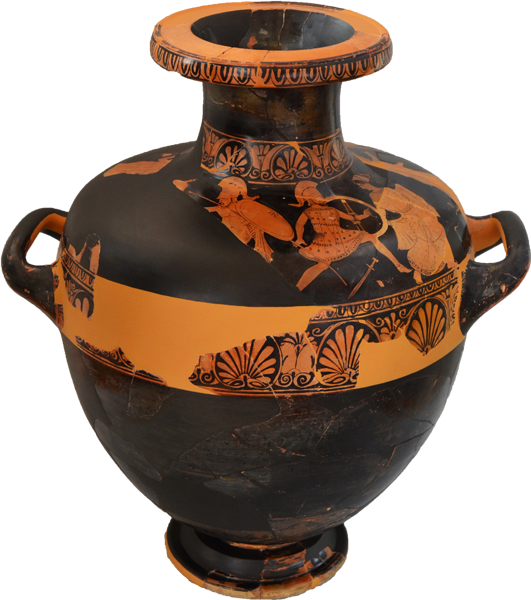Exhibit of the month
Love that heals all wounds …
Attic red-figure hydria, vase painting attributed to Polygnotos
National Archaeological Museum
Vase and Minor Arts Collection, inv. no A14983
Provenance: Unknown (acquisition)
Dimensions: Height: 46 cm
Date: 450-445 BC
Display location: Vase Collection, Room 55, Showcase 114
The shoulder of the hydria is decorated with themes inspired by Iliou Persis (The Sack of Ilium)[1]. This poem does not survive, yet through serendipity the content of the lost epics of the Trojan Cycle is preserved —albeit briefly— in the work of the grammatician or philosopher Proclus[2]. The vase depicts the sacrilege committed by Ajax who, having transgressed the human moral standards, rapes Cassandra, the beautiful daughter of Priam, inside the temple of the goddess Athena where she sought refuge as a supplicant. Unfortunately, only the figure of the Locrian hero is fragmentarily preserved from the scene.
Next to him Menelaus encounters after twenty years beautiful Helen for the sake of whom so many Achaeans died. The Spartan king has sworn to kill her. At the sight of her, determined to take revenge for all those unnecessary deaths of his comrades he pulls his sword. However, as he meets her gaze the man drops his sword. He continues to pursue her though, as relentlessly as before, yet now as a lover who claims her from the start, while the woman is desperately trying to escape taking refuge together with two companions in an altar .
The representation of this vase differentiates from the widespread version of the myth[3], according to which when the couple met again, Helen, fearless before her enraged husband, remaining silent, simply exposed her breasts. Once again Menelaus could not resist her beauty. From pursuer he turned again into her captive and surrendered himself to her, letting his sword drop.
[1] His creator is considered to be the poet of the 7th century B.C. Arktinus of Miletus.
[2] This is Proclus, the Neoplatonic philosopher of the 5th A.D. century or Eutychius Proclus, grammarian of the 2nd A.D. century. His work is called Selections of Chrestomathy grammar and it is the only work of antiquity that presents, albeit in a summary manner, the content of the lost epics of the Trojan circle.
[3] According to one version of the myth, Helen, in order to escape the just wrath of her husband, takes refuge in the temple of Aphrodite (Ibycus fragment 15 Ρ). In another version, Menelaus believes that it was not his wife’s fault that Paris abducted her and he immediately reconciles with her («The Sack of Ilium» Proclus 92, Apollodorus, Epitome 5, 22). In Stesichorus, it is the Achaeans that decide to sentence her to death by stoning, when though they set eyes on her, the stones fall out of their hands (fragment 24 Ρ).
Dr Efi Oikonomou
Suggested bibliography:
Kroh, P., Λεξικό αρχαίων συγγραφέων, s.v. Πρόκλος γραμματικός, ed. USP, 1996.
Τζεδάκις, Γ., ed. Από τη Μήδεια στη Σαπφώ. Ανυπότακτες γυναίκες στην αρχαία Ελλάδα, Αθήνα, 1995, p. 137.
Κακριδής, Ι. Θ. (ed.), Ελληνική Μυθολογία , Vol. 5, Αθήνα, 1987.
LIMC IV, 1 (1988), p. 543 (s.v. Helene, no 269).


